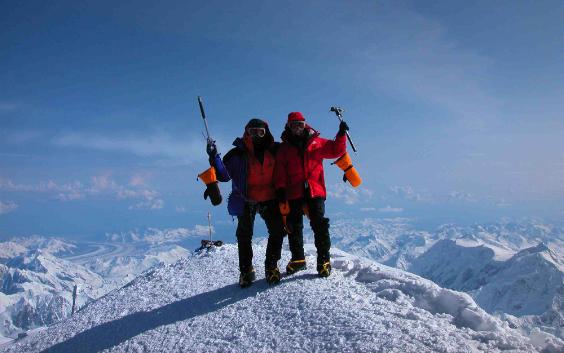 |
|||
|
||||||||||||||||||||||||||||||||||||||||||||||||||||||||||||||||||||||||||||||||||||||||||||||
 |
||||||||||||||||||||||||||||||||||||||||||||||||||||||||||||||||||||||||||||||||||||||||||||||
Height: 6,194 metres / 20,320 feet OUR CLIMB …Summit date: 12th June 2003 BACKGROUND …Denali it’s native Inuit name means “Great One” and at 63 degrees North, it lies very close to the arctic circle. The flanks of Denali rise dramatically from the foot of the mountain where it meets the tundra for over 6,096 metres (20,000 feet) making this possibly the single most impressive mountain in the world. It rises alone with only nearby Mount Foraker even close to it in height. Denali gained its more recent name of McKinley in 1897, named after the 25th U.S. president, William McKinley … even though he’s never climbed it and it was his assassination that really seemed to make the name stick! Denali is part of the Alaska range, and although the range itself is comprised of incredible jagged and icy peaks, next to Denali’s bulk they seem like mere foothills. Of the seven continental summits it is considered the second most difficult, only being surpassed by Everest. Unlike the Himalayas though there are no yaks to carry loads to base camp or sherpas to help with equipment higher on the mountain. Everything from food, fuel, tents, sleeping bags and even waste matter has to be carried on this mountain. Due to its northerly latitude Denali is one of the coldest mountains in the world outside Antarctica with the summit temperatures being below minus 15 degrees celcius almost all of the time. Being closer to the lower pressure that exists at the north pole makes its altitude seem more like that of a 7,000 metre (22,966 feet) peak. The weather that surrounds Denali is notorious for changing dramatically and quickly and making it imperative that climbers pay attention to their climbing strategy at all times. Being successful on Denali is often a matter of getting into position, waiting for weather to clear then going for the summit. In a normal year only 50% of all who attempt to climb Denali will summit, even going via the most accessible West Buttress route. Although the most straight forward route it still involves crossing lots of glaciated terrain, climbing a steep 2000 foot ice headwall, negotiating a narrow and often windswept ridge at 4,877 metres (16,000 feet) whilst carrying heavy loads and moving across avalanche prone terrain. It is an arduous undertaking but the summit views on a clear day that stretch to the Pacific ocean by Anchorage are unique and a worthy reward for those who make it. |
||
|
